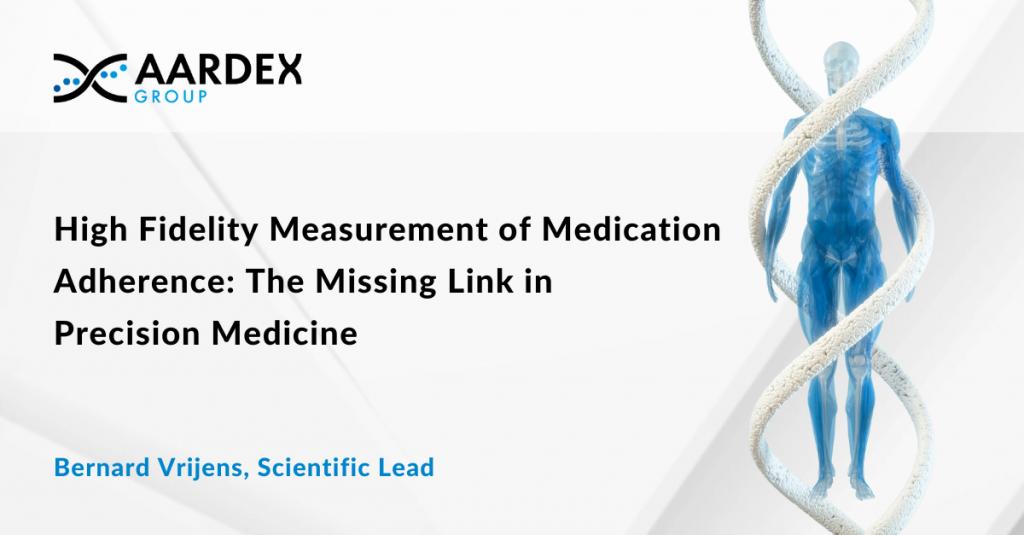The emergence of pharmacogenomics is an important milestone in the precision medicine journey – but the importance of measuring medicine adherence, an essential component in the complex pharmacokinetics/ pharmacodynamics equation, can often be overlooked.
In this article, Bernard Vrijens, CEO and Scientific Lead at AARDEX Group, argues that the industry must use every tool in its armoury, including connected packaging, to ensure this fresh approach to research is translated into patient benefit as quickly and effectively as possible.
What is pharmacogenomics?
In the United States, the Right Drug Dose Now Act is currently making its way through the House of Representatives. If enacted, it will update the National Action Plan for Adverse Drug Event Prevention to include educational information on how adverse events (AEs) can be reduced through pharmacogenetic testing.
The basis of this approach is that, while drug metabolism is dependent on metabolizing enzymes, how these enzymes are encoded and produced varies from person to person. It means that two people can take the same drug dose, and have two different reactions, by virtue of their genes.
Pharmacogenomics is guided by the biochemical interactions between the body’s natural processes and the chemical composition of a pharmaceutical drug – namely pharmacokinetics (PK) and pharmacodynamics (PD). While PK describes a drug’s absorption, distribution, metabolism, and excretion, PD relates to how biological processes in the body respond to, or are impacted by, the drug in question.
However, PK and PD calculations are obviously misleading if the person is not taking the medication, is taking it erratically, or is taking too much. It means that medication adherence should be the foundation of any accurate pharmacogenomic analysis.
Appropriate dose selection
Much of the information used to understand PD and PK is collected during early phase clinical trials.
During these studies, researchers analyse safety and efficacy with regards to all manner of variables, including age, race, and ethnicity, all of which will influence how an individual responds to a drug. And by pinpointing the genetic factors that impact medication effect, pharmacogenomics adds another variable to the dose selection determination.
It is an incredibly important process as it determines the dose at which the investigational product will, if successful, move into large scale trials, and then into market. Getting it wrong can lead to the failure of late-stage studies or unexpected AEs, as well as the need for dose adjustment during phase III or even post-marketing.
Adherence and dose selection
One variable that can often be overlooked, despite underpinning every element of treatment response, is adherence – because determining PD and PK is irrelevant if researchers cannot be sure that all participants have taken the medicine as directed.
This concern is compounded by the emergence of modern dose finding study designs. Unlike traditional 3+3 approaches, model-based and model-assisted frameworks allow for dose escalation as de-escalation, and require fewer participants to reach full power.
This reduces the overall risk of exposure to toxicity, but also means researchers are increasingly making dose selection decisions on much smaller sample sizes. If even one patient is non-adherent without the team’s knowledge, then, this can have a significant impact on PK and PD calculations.
Connect to adherence
Sponsors and CROs have grappled with the problem of poor medication adherence for decades, but it has – until recently – gone unsolved.
The problem, at least in part, has been that traditional monitoring methods, whether they be pill counts, blood sampling, or HCP/self-reporting, are just not sensitive enough to provide real value.
For example, patients can easily censor methods that rely on counting returned doses. Furthermore, this approach provides a but a snapshot of medicine taking behavior between site visits. Pharmacogenomics and dose selection decisions, however, need to be driven by a holistic overall understanding of treatment initiation and dosing patterns needed.
When it comes to monitoring drug or drug metabolites in blood, urine, or hair, “white coat adherence”, or people only taking the investigational product a few days before their site visit, is a concern. Self-, site- or HCP-report, meanwhile, are all vulnerable to inaccuracies and bias that can result inaccurate and incomplete data.
Digital monitoring, which combines the power of connected drug packaging and data analytics, is different. Because it is objective and precise it is able to provide the overall view of medication taking behavior teams need to make dose selection decisions.
Connected packages, including inhalers, blister packs, or pre-filled syringes, record the time and date of dose administration, as well as other essential information such as batch number. This data is then automatically transmitted to the study team’s cloud-based platform. Sophisticated algorithms then take over, analysing the provided information to identify erratic dosing patterns that could signal an adherence problem.
The method is simple and, by providing researchers with a real-time picture of adherence, it provides all the information they need to make informed, accurate dose selection calculations.
Connected packaging is not the stuff of science fiction. It is here now, ready to use, and evidence based. In fact, studies have shown that it is 97% accurate. That’s compared to 60% for pill count, 50% for healthcare professional rating, and just 27% for self-report.1
The time is now
New approaches to research, including pharmacogenomics and new dose selection study designs, are promising to take drug development to the next level – from personalized medicine to cutting edge innovations like gene and cell therapies, we are standing on the precipice of a golden age in medicine.
First, we need to make sure we have all the foundations in place. Connected packaging and digital adherence monitoring is one such way to ensure researchers have all the information they need to develop the medicines of the future.
References
- Alili, M., Vrijens, B., et al. A scoping review of studies comparing the medication event monitoring system (MEMS) with alternative methods for measuring medication adherence. (2016). https://pubmed.ncbi.nlm.nih.gov/27005306/



